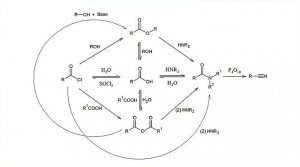Playlist
Show Playlist
Hide Playlist
Nucleophilic Substitution – Carboxylic Acids and Their Derivatives
-
Slides 08 Chemistry Advanced Le Gresley.pdf
-
Download Lecture Overview
00:01 So, nucleophilic substitution. 00:04 Now, this is a different take on what we originally know to happen with carbonyl compounds. Carbonyl compounds, as we saw in the previous lecture, undergo nucleophilic addition, that is to say the carbon-oxygen double bond is broken and you have a tetrahedral structure of an addition product formed. However, what makes these carboxylic acids derivates so useful and so reactive is that they undergo a nucleophilic addition followed by elimination reaction which is otherwise known as a nucleophilic substitution. 00:40 So, let’s have a look at this very sort of basic example where we have got a carboxylic acid derivative where Z could be any of those chaps shown underneath that particular equation; let’s just say, for the sake of argument, it is a chloride and we have a nucleophile which is shown above the double headed arrows showing dynamic equilibrium as Nu-. 01:02 First thing that happens, of course, is it being negatively charged, it attacks the carbonyl carbon, it opens up that carbon-oxygen double bond and formally puts a negative charge on that oxygen. However, what then happens is that you have got the reformation of that carbon-oxygen double bond and the loss of whatever group Z is. In this case, if we say it was chlorine, it would mean that we would lose chloride. 01:34 So, if we react an acetyl chloride or an acid chloride with a nucleophile, we would usually displace the chloride and introduce the nucleophile on that carbonyl carbon. And this is why I say, you can call it substitution or as some people prefer it, an addition elimination reaction. 01:57 So, to start off with, the bond is opened, then it is reformed again. And in this regard, the oxygen is regarded to serve as an electron sink where we need to put the electrons back in to kick off Z which is… well, has to be a better leaving group than the nucleophile you started with. This reaction happens, to stress only if the nucleophile is a strong… Nu- is a stronger nucleophile than the Z- leaving group. So, Z- must be a leaving group. 02:27 So, let’s look at an example reaction, not with something simple like an acid chloride, but with, for example, an ester shown here. Note the same format: we have here a carbonyl carbon to which the carbon of that… where the oxygen is, is attached to an OR group and now, what we are doing is we are reacting it with a Grignard reagent. 02:50 Now, I think we touched briefly on Grignard reagents earlier on. To all intents and purposes and as far as you are concerned, all you should need to know is in a case of a Grignard reagent, the alkyl group, in this case a methyl, is said to carry a full negative charge. This effectively means that Me- is the nucleophile, Me- is the nucleophile can attack the carbonyl carbon, open up that carbon-oxygen double bond. 03:20 And remember what I said before, once it’s opened up then what it can do is it can reform and kick out the leaving group Z, which, in this case, happens to be an alkoxide group; this is an alcohol which has been deprotonated. Now, of course, what this gives us here is now as you can hopefully see, a ketone. What we have done is we have actually substituted that OR prime group with a methyl group and so, we have generated a ketone. At the same time, we have also generated magnesium alkoxide. 03:59 What I would like you to do is, well, then, is consider what the effects would be if we actually had an excess of the Grignard reagent because as we have already said, carbonyl compounds, even ketones, also react with nucleophiles via nucleophilic addition. And so, in an excess of methyl magnesium bromide, you would find that this product would not remain much around for longer and will be converted into corresponding dimethyl alcohol.
About the Lecture
The lecture Nucleophilic Substitution – Carboxylic Acids and Their Derivatives by Adam Le Gresley, PhD is from the course Organic Chemistry.
Included Quiz Questions
Which of the following is NOT true about the reactivity of carboxylic acid derivatives?
- Incoming nucleophile attacks on the delta negative charge of oxygen atom of the carbonyl group.
- Carboxylic acid derivatives undergo nucleophilic substitution reaction involving nucleophile addition on the carbonyl carbon in the first step followed by an elimination reaction.
- Nucleophilic substitutions of acid derivative take place only when the attacking species is a stronger nucleophile than the leaving group.
- The oxygen atom of the carbonyl group of acid derivative acts as an electron sink during nucleophilic substitution.
- The good leaving groups favor the nucleophilic substitutions in acid derivatives.
What is the geometry and hybridization of intermediate formed during nucleophilic substitution of carboxylic acid derivatives?
- Tetrahedral geometry and sp3 hybridization
- Trigonal planar geometry and sp2 hybridization
- Linear geometry and sp hybridization
- Trigonal bipyramidal geometry and dsp3 hybridization
- Octahedral geometry and d2sp3 hybridization
Which of the following statements is NOT true for the reaction between C4H9COOCH3 and C3H7MgBr?
- C4H9COOCH3 gets converted to C3H7COCH3 via a nucleophilic elimination reaction.
- C4H9COOCH3 gets converted to C4H9COC3H7 via nucleophilic substitution reaction.
- The C3H7MgBr acts as a Grignard reagent and exists in a polarized form in the reaction mixture.
- The Grignard reagent gets converted to magnesium alkoxide.
Customer reviews
5,0 of 5 stars
| 5 Stars |
|
5 |
| 4 Stars |
|
0 |
| 3 Stars |
|
0 |
| 2 Stars |
|
0 |
| 1 Star |
|
0 |




